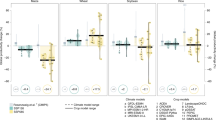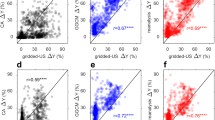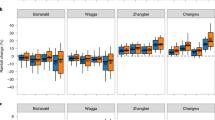Abstract
Rice is the staple food for more than 50% of the world's population1–3. Reliable prediction of changes in rice yield is thus central for maintaining global food security. This is an extraordinary challenge. Here, we compare the sensitivity of rice yield to temperature increase derived from field warming experiments and three modelling approaches: statistical models, local crop models and global gridded crop models. Field warming experiments produce a substantial rice yield loss under warming, with an average temperature sensitivity of −5.2 ± 1.4% K−1. Local crop models give a similar sensitivity (−6.3 ± 0.4% K−1), but statistical and global gridded crop models both suggest less negative impacts of warming on yields (−0.8 ± 0.3% and −2.4 ± 3.7% K−1, respectively). Using data from field warming experiments, we further propose a conditional probability approach to constrain the large range of global gridded crop model results for the future yield changes in response to warming by the end of the century (from −1.3% to −9.3% K−1). The constraint implies a more negative response to warming (−8.3 ± 1.4% K−1) and reduces the spread of the model ensemble by 33%. This yield reduction exceeds that estimated by the International Food Policy Research Institute assessment (−4.2 to −6.4% K−1) (ref. 4). Our study suggests that without CO2 fertilization, effective adaptation and genetic improvement, severe rice yield losses are plausible under intensive climate warming scenarios.
This is a preview of subscription content, access via your institution
Access options
Subscribe to this journal
Receive 12 digital issues and online access to articles
$119.00 per year
only $9.92 per issue
Buy this article
- Purchase on Springer Link
- Instant access to full article PDF
Prices may be subject to local taxes which are calculated during checkout



Similar content being viewed by others
References
FAOSTAT (FAO, 2014); http://faostat.fao.org/default.aspx
Seck, P. A., Diagne, A., Mohanty, S. & Wopereis, M. C. S. Crops that feed the world 7: rice. Food Secur. 4, 7–24 (2012).
Maclean, J. L., Dawe, D. C., Hardy, B. & Hettel, G. P. Rice Almanac: Source Book for the Most Important Economic Activity on Earth 3rd edn (CABI Publishing, 2002).
Nelson, G. C. et al. Food Security, Farming, and Climate Change to 2050: Scenarios, Results, Policy Options (IFPRI, 2010).
Godfray, H. C. J. et al. Food security: the challenge of feeding 9 billion people. Science 327, 812–818 (2010).
Foley, J. A. et al. Solutions for a cultivated planet. Nature 478, 337–342 (2011).
Gourdji, S. M., Sibley, A. M. & Lobell, D. B. Global crop exposure to critical high temperatures in the reproductive period: historical trends and future projections. Environ. Res. Lett. 8, 024041 (2013).
Sánchez, B., Rasmussen, A. & Porter, J. R. Temperatures and the growth and development of maize and rice: a review. Global Change Biol. 20, 408–417 (2014).
Rosenzweig, C. & Parry, M. L. Potential impact of climate change on world food supply. Nature 367, 133–138 (1994).
Asseng, S. et al. Uncertainty in simulating wheat yield under climate change. Nat. Clim. Change 3, 827–832 (2013).
Challinor, A. J. et al. A meta-analysis of crop yield under climate change and adaptation. Nat. Clim. Change 4, 287–291 (2014).
Rötter, R. P., Carter, T. R., Olesen, J. E. & Porter, J. R. Crop–climate models need an overhaul. Nat. Clim. Change 1, 175–177 (2011).
Warszawski, L. et al. The inter-sectoral impact model intercomparison project (ISI–MIP): project framework. Proc. Natl Acad. Sci. USA 111, 3228–3232 (2014).
Rosenzweig, C. et al. The agricultural model intercomparison and improvement project (AgMIP): protocols and pilot studies. Agric. For. Meteorol. 170, 166–182 (2013).
Li, T. et al. Uncertainties in predicting rice yield by current crop models under a wide range of climatic conditions. Global Change Biol. 21, 1328–1341 (2015).
Cox, P. M. et al. Sensitivity of tropical carbon to climate change constrained by carbon dioxide variability. Nature 494, 341–344 (2013).
Hall, A. & Qu, X . Using the current seasonal cycle to constrain snow albedo feedback in future climate change. Geophys. Res. Lett. 33, L03502 (2006).
Rosenzweig, C. et al. Assessing agricultural risks of climate change in the 21st century in a global gridded crop model intercomparison. Proc. Natl Acad. Sci. USA 111, 3268–3273 (2014).
Kimball, B. A. Theory and performance of an infrared heater for ecosystem warming. Global Change Biol. 11, 2041–2056 (2005).
Aronson, E. L. & McNulty, S. G. Appropriate experimental ecosystem warming methods by ecosystem, objective, and practicality. Agric. For. Meteorol. 149, 1791–1799 (2009).
De Boeck, H. J. & Nijs, I. An alternative approach for infrared heater control in warming and extreme event experiments in terrestrial ecosystems. J. Ecol. 99, 724–728 (2011).
Lobell, D. B. et al. Prioritizing climate change adaptation needs for food security in 2030. Science 319, 607–610 (2008).
Maltais-Landry, G. & Lobell, D. B. Evaluating the contribution of weather to maize and wheat yield trends in 12 U.S. counties. Agron. J. 104, 301–311 (2012).
Schlenker, W. & Roberts, M. J. Nonlinear temperature effects indicate severe damages to US crop yield under climate change. Proc. Natl Acad. Sci. USA 106, 15594–15598 (2009).
Ziska, L. H. & Bunce, J. A. Predicting the impact of changing CO2 on crop yields: some thoughts on food. New Phytol. 175, 607–618 (2007).
Ainsworth, E. A. Rice production in a changing climate: a meta-analysis of responses to elevated carbon dioxide and elevated ozone concentration. Global Change Biol. 14, 1642–1650 (2008).
Howden, S. M. et al. Adapting agriculture to climate change. Proc. Natl Acad. Sci. USA 104, 19691–19696 (2007).
Hall, A. J. & Richards, R. A. Prognosis for genetic improvement of yield potential and water-limited yield of major grain crops. Field Crop. Res. 143, 18–33 (2013).
Fischer, G. How do Climate Change and Bioenergy Alter the Long-Term Outlook for Food, Agriculture and Resource Availability? (FAO, 2009).
Porter, J. R. et al. in Climate Change 2014: Impacts, Adaptation and Vulnerability (eds Field, C. B. et al.) 485–533 (Cambridge Univ. Press, 2014).
Hempel, S., Frieler, K., Warszawski, L., Schewe, J. & Piontek, F. A trend-preserving bias correction–the ISI-MIP approach. Earth Syst. Dyn. 4, 219–236 (2013).
Acknowledgements
We thank the Intersectoral Impact Model Intercomparison Project (ISI-MIP) and the Agricultural Model Intercomparison and Improvement Project (AgMIP) for providing crop model simulation results. We also thank S. Asseng for helpful comments. This study was supported by the National Natural Science Foundation of China (41530528 and 41561134016), the 111 project (B14001) and the National Youth Top-notch Talent Support Program in China. The research of P.C., I.A.J. and J.P. was supported by the European Research Council Synergy grant ERC-2013-SYG-610028, IMBALANCE-P. C.M. acknowledges financial support from the MACMIT project (01LN1317A) funded through the German Federal Ministry of Education and Research (BMBF).
Author information
Authors and Affiliations
Contributions
S. Piao designed the research, C.Z. performed the analysis and all authors contributed to the interpretation of the results and the writing of the paper.
Corresponding author
Ethics declarations
Competing interests
The authors declare no competing financial interests.
Supplementary information
Supplementary Information
Supplementary Methods, Supplementary References, Supplementary Figures 1-12, Supplementary Table 1, Appendix 1-3. (PDF 1428 kb)
Rights and permissions
About this article
Cite this article
Zhao, C., Piao, S., Wang, X. et al. Plausible rice yield losses under future climate warming. Nature Plants 3, 16202 (2017). https://doi.org/10.1038/nplants.2016.202
Received:
Accepted:
Published:
DOI: https://doi.org/10.1038/nplants.2016.202
This article is cited by
-
Evolution of drought characteristics and propagation from meteorological to agricultural drought under the influences of climate change and human activities
Environmental Science and Pollution Research (2024)
-
Enhancing sustainable development through plant genetics
Nature Reviews Genetics (2023)
-
The optimization of model ensemble composition and size can enhance the robustness of crop yield projections
Communications Earth & Environment (2023)
-
From species norms to communal metrics: advancing plant community-level historical phenology and phenological ecology
Plant Ecology (2023)
-
Genetic variation analysis of pleiotropic gene Ghd7 in rice
Plant Growth Regulation (2023)



